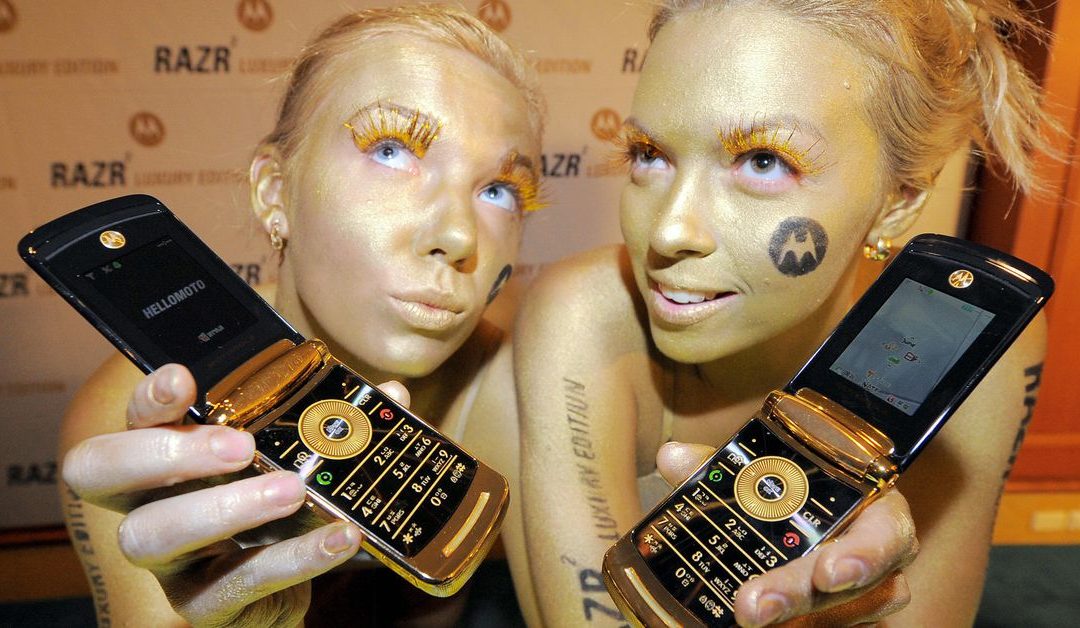The Motorola Razr V3 was the coolest flip phone of all time, and now it’s coming back. Kind of.
Leaked renderings of the new Motorola Razr — a reportedly $1,500 phone with no launch date yet — hit the internet on Monday. It looks just like the old RAZR, except shorter and square, like a little phone compact mirror. And of course, it’s a smartphone, unlike the old Razr, so you fold it open to reveal a full-length touchscreen.
The plan to release a new Razr, called the V4 , was reported by the Wall Street Journal in January, and confirmed by the phone maker in February. Aside from some patent drawings, these leaks are the first anyone’s seen of the undead Razr. Nevertheless, the buzz has been building for months.
That’s because the famous Motorola Razr V3 was the most popular phone in America for nearly four years — 2004 to 2008 — and the first phone to serve as a luxury status symbol, as David Pierce argued in The Verge’s “Status Symbol” column in 2013.
“At the time, all cell phones had started to turn into these handy, nondescript, amorphous things,” former Motorola head of design Jim Wicks told Pierce. “So the idea of going out and doing this thing that was very, very different would cut against everything everyone else was doing with handsets at the time.” The selling point of the Razr was that it was super-thin — the keyboard did away with rounded buttons in favor of a flat metal grid, and the phone’s processors were packed into that rectangular chin at the bottom.
The other selling point was that the Razr was wildly expensive in comparison to the market at the time. This was when devices could basically just send SMS texts and take crummy photos and make phone calls and play simple, horrible mobile games, and you could easily get a free phone when you signed up for a plan. But the Motorola Razr V3, in stark contrast, was $449.
It was deliberately marketed as a product for the cultural elite. In June 2004, it made its debut at the Arken Museum of Modern in Copenhagen in front of a crowd of fashion journalists, not gadget bloggers. “The RAZR had going for it the only thing that really mattered,” Pierce writes. “It was cool. The phone showed up in gift bags at the Oscars, in ads with Maria Sharapova, in Jason Bourne’s pocket, and as a Monopoly token.”
My twin cousins shared a pink Motorola Razr V3, and no offense to their personalities, but it factored heavily into their leg-up over me in the social pyramid of our suburban middle school. Even several years after the Razr’s true heyday, Shay Mitchell’s character carried a Razr V3i for part of the first season of Pretty Little Liars. (She then swapped it out for the short-lived Microsoft Kin, which she dumped for a Samsung Intercept. That show had so many weird phones.)
Other phone makers try to mimic the status symbol strategy — LG’s enV (pronounced “envy”) came close in 2006 — but a decade later, it remains to be seen if that cool-girl magic can be recreated for a post-smartphone audience.
Earlier this month, tech writer Simon Rockman warned that we should “prepare to be disappointed” by the new Razr. It’s not a totally unfair claim. Foldable smartphones have been promised as the hot new gadget of 2019 — a way for smartphone design to be exciting again — but the results so far have been pretty unimpressive. Samsung’s nearly $2,000 Galaxy Fold was supposed to debut last week, but the company delayed the launch until at least June, after sample units sent to tech review sites broke almost immediately. Huawei’s more-than-$2,000 foldable phone won’t be out until July, and reports suggest that it could be a small-batch novelty item.
Rockman’s argument has less to do with the broader industry and more to do with the fact that the new Razr isn’t actually going to be built by Motorola, because Motorola is not really a company anymore. It’s more a collection of patents and brand name — like the modern “Blackberry” — which Lenovo acquired in 2014. Motorola crumbled in 2009 after failing to predict or adapt to the age of the smartphone and hemorrhaging money in the iPhone’s first two years on the market. This is a totally different design team, and they could muck it up.
But if the V4 is, at a minimum, functional and foldable, and looks like the phone that inspired bitter high school rivalries, it will be more interesting than the current iPhone. Smartphone design could be weird again! 2019 could be the year of the super-expensive flip-phone comeback, which doesn’t sound exactly like something anyone needs, but does sound kind of fun.
Want more stories from The Goods by Vox? Sign up for our newsletter here.
